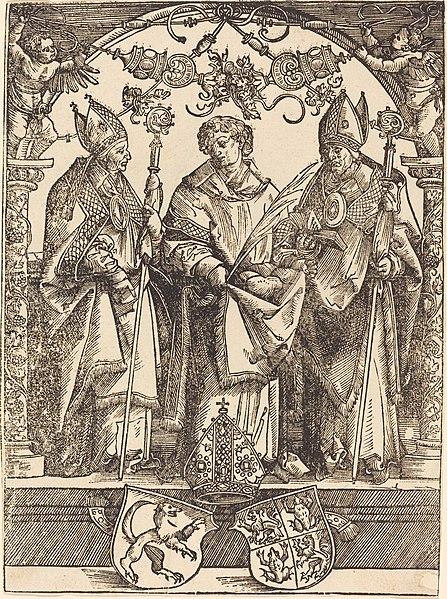Sincerely, Your Valentine

Although St. Valentine is one of the better known saints in twenty-first-century America because of the lavish celebration of his holiday on February 14th, like many of the other popular martyrs we’ve written about here at All the Household, his likeness has frequently been misconstrued within popular culture.
One of the reasons for this is that there is some debate regarding who Valentine was; after all, Valentine was a popular name in the early centuries after Jesus’ ascension, which is why there are thought to be as many as three possible “true” St. Valentines whose stories differ and overlap in various regards. It’s also possible, though, that there was just one man whose life was retold in various fashions! But even if we do not know all the details of St. Valentine’s life, we’ll try to sketch what we do know and what the various traditions concerning his life are so that we can see how his own example of faith can benefit our own piety.
According to tradition, St. Valentine was martyred around AD 270 under Emperor Claudius II, almost surely in connection to his faith and work in the early Church, and was buried at a Christian cemetery in the north of Rome. Yet there is some mystery surrounding the reason he was put to death.
There is also some mystery regarding what his profession was and why he began to be connected with love. Some early writings hold that he was a priest, a doctor, and/or a bishop. Likewise, a popular tradition surrounding his connection with love holds that St. Valentine was a prominent figure within the early Church and played an important role in promoting Christian marriage during a time when Christians were persecuted and not permitted to marry. After all, it was customary during this time for young unmarried men to be pushed into military careers and not to be permitted to start families. As a result, St. Valentine is said to have been a priest who performed secret marriages and thus earned his title as the patron saint of couples and love.
But another possible aspect of Valentine’s life that connects him with love and marriage is the belief that he is said to have won the affection of his jailor’s daughter when he was imprisoned by the state. Reportedly, St. Valentine confessed Christ to the jailor and wrote a letter of Christian encouragement to the daughter, which he signed, “Your Valentine.” This story forms the basis for today’s tradition of sending letters of love and encouragement on St. Valentine’s Day.
Yet another story about Valentine includes the legend that when the saint was a bishop of Terni, Italy he came across a lame boy in the road who was unable to speak or stand. After a night of fervent prayer it was said that the saint was able to heal a lame boy. These are the reasons why in many artistic depictions of the saint he is either positioned next to a boy laying at his feet or among the couples that Valentine was said to have married.
A Brief History
The details of St. Valentine’s life are weak, the tradition of commemorating him is strong. He appears first in the Martyrologium Hieronymianum, one of the earliest martyrologies, a compilation of Roman, African and Greek martyr calendars that was compiled around the fourth century and reproduced down through the centuries. Pope Gelasius I established St. Valentine’s feast in AD 496. The commemoration has since been removed from the official Roman calendar, but it remains in our Lutheran sanctoral cycle and is celebrated on the famous February 14th date, the date of Valentine’s martyrdom.
Many of the aforementioned stories regarding St. Valentine are believed to be later additions that were invented to connect him with the love-themed traditions we all know today. These could have been generated in part due to Geoffrey Chaucer’s fourteenth-century poem linking St. Valentine’s day in mid-February with birds’ peak mating season, thus encouraging romance themes around the feast day itself.

However, this strong cultural association between Valentine and love does not have to be entirely disregarded as historically inaccurate or contrary to the work of the church. Instead, his day can provide an opportunity for Christians to reflect upon the importance of church community, families, and friendship and to think about the trajectory of saints’ stories within secular society. At the very least, we support the practice of using February 14th to teach those in your household about Valentine as an example of someone who demonstrated life-giving devotion to his Lord, charity, and self-sacrifice for his neighbors.

Collect
Grant, we beseech Thee, O Almighty God: that we who celebrate the birthday of blessed Valentine, Thy Martyr, may be inspired to imitate his faith; through Jesus Christ, Thy Son, our Lord, who liveth and reigneth with Thee and the Holy Ghost: ever one God, world without end. Amen.
Lessons
Epistle
Gospel
Resources
Issues, Etc. interview with the Rev. Dr. Joel Elowsky David Petersen on the Third Century Martyr Valentine
Issues, Etc. interview with the Rev. Will Weedon on the Third Century Martyr Valentine
Propers found in Daily Divine Service Book: A Lutheran Daily Missal, edited by the Rev. Heath Curtis
References:
1. Voragine, Jacobus de. The Golden Legend: Reading on the Saints. Vol. 1. Translated by William Granger Ryan. Princeton Press. 1993.
2. Weedon, William. Celebrating the Saints. Concordia Publishing House. 2016.
3. Catholic Education Resource Center entry on the History of St. Valentine
Images:
1. Saints Maximilian, Stephen, and Valentine, Wolf Trout, Germany, ca. 1486-1520.
2. Saint Valentine, Leonhard Beck, Germany, 1510.
3. St. Valentine Baptizing St. Lucilla, Jacopo Bassano, Italy, 1575.




